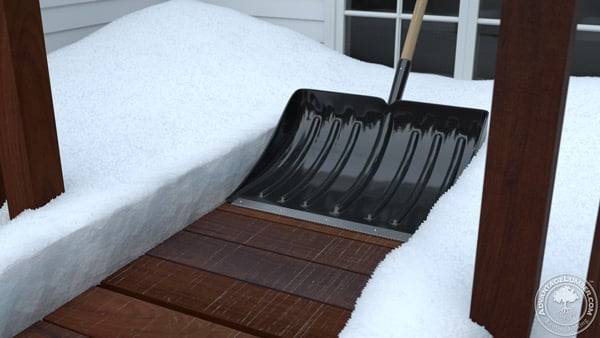Winter is almost here, and snow is in the forecast for most of the US. For children, this means snowmen, snowball fights, and hot chocolate. For adults it means buried cars, shorter days, and snowed-in driveways.
It’s customary to use rock salt for removing snow from sidewalks and driveways, but using salt on your deck can actually cause more harm than good.
Using rock salt will:
- Discolor your deck
- Corrode fasteners, especially if they’re galvanized or if the stainless steel isn’t rated for salt use
- Dry out boards and cause surface cracking.
The best way to remove snow from your deck is with a shovel. However, in order to avoid damaging the surface of the boards you need to use the right shovel. Shovels with rubber tips and wide fronts will remove snow faster without harming the deck’s surface. Using steel tipped shovels will scratch and damage your deck.
When shoveling, make sure to shovel along the grain of the board or you may risk damaging them. Our main picture shows exactly the scuffing and scratches that occur when using a metal tip shovel and removing snow against the grain of the boards. Once most of the snow is shoveled off, sweep the excess off your deck to ensure no large puddles are created.
It’s always important to prepare before a storm hits. But in your rush to beat the snow, don’t make deck-damaging mistakes. Avoiding rock salt and using the correct shovel will help preserve your deck for spring.



Since you specifically mention rock salt in your article, I’m assuming that other ice melting chemicals are ok, or you would have mentioned not using them as well.
BTW no one that I know uses chemicals on snow, but on the ice underneath after shoveling.
Good idea. Thanks I bar b que on my deck all winter long!
Hi Roger,
Rock salt is not recommended but there are some pet friendly urea-free products that can work to melt snow without damaging the boards. Chemicals used for Ice would have to fall under the same category. However, always exercise caution and consult with the manufacturer and test it in an inconspicuous area.